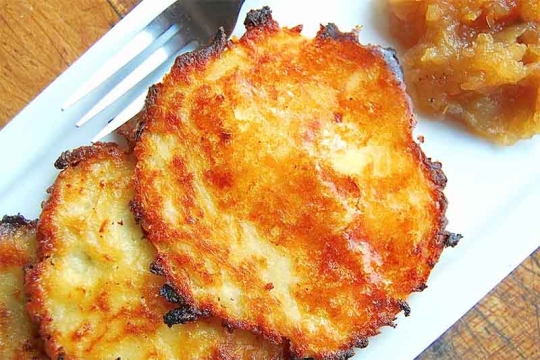Latkes — potato pancakes — are generally made by standing over a hot stove, grease sputtering and popping, and frying the cakes 2 or 3 at a time. It's a long, labor-intensive process. Here's a better method: bake them in the oven, so you can serve a dozen hot latkes, all at once, with very little effort.
In addition, latkes are traditionally made with raw grated potatoes, squeezed dry in a towel or pressed in a colander to remove their liquid. Here's an easier method: cook the potatoes first, then put them through a potato ricer. Gently combine with the remaining ingredients, bake, and you'll make latkes that are crispy-crunchy outside, and soft within.
And homemade applesauce doesn't mean standing over a hot stove, either. Simply core apples (peels on or off; your choice); microwave till soft; mash; and sweeten to taste. The combination of sweet applesauce and salty latkes simply can't be beat. Enjoy!
- Peel the potatoes. Cut each potato into about 6 chunks.
- If you're using baking potatoes, place them on a microwave-safe plate. Sprinkle with 1 to 1 1/2 teaspoons salt, to taste (more if you like a saltier latke). Cover the plate with plastic wrap, and microwave for about 10 minutes, until the potatoes are soft.
- If you're using yellow boiling potatoes, cut each of the chunks in half, and place them in a medium saucepan. Cover with about 4 cups of water; the water should cover the potatoes by about 1/2". Add 1 1/2 to 2 tablespoons salt to the water (yes, tablespoons; use the greater amount if you like saltier latkes). Boil the potatoes for about 8 minutes, or until they're fork tender. Drain in a colander.
- Allow the potatoes to cool a bit while you shred or dice the onion, and whisk the egg. Preheat the oven to 400°F.
- Use a potato ricer to rice about 1/3 of the cooked potatoes into a bowl. Sprinkle with half the onions and 1 tablespoon of the flour, and drizzle with about half the beaten egg. Rice another third of the potatoes into the bowl, and sprinkle with the remaining onions and flour; drizzle with the remaining egg. Rice the remaining potatoes into the bowl.
- Gently combine all of the ingredients. Don't stir too much; you don't want thoroughly mashed potatoes.
- Line two rimmed baking sheets with easy-release aluminum foil (for easiest cleanup, and guaranteed no-stick latkes). Or simply get out two rimmed baking sheets. Pour 1/4 cup oil into each, tilting the pan to spread it around.
- Place one of the pans into the oven, and allow the oil to heat for 2 minutes. this step isn't necessary if you use easy-release aluminum foil, but helps avoid sticking if you're using a plain aluminum foil.
- If you've heated the pan, remove it from the oven. Scoop a heaping 1/4 cup of potatoes onto the pan; a muffin scoop works well here. Repeat till you've scooped 6 or 7 latkes onto the pan. Using the back of a spoon or your fingers (be careful!), gently flatten the latkes to about 3/8" thick.
- Repeat with the second pan and the remaining potatoes.
- Bake the latkes for 10 minutes. Reverse the pans in the oven — upper pan to the lower rack, lower pan to the upper rack — and bake for an additional 15 minutes, till the bottoms of the latkes are golden brown.
- Remove the pans from the oven, and carefully flip the latkes. If you're not using easy release foil, and they stick, try baking for a few more minutes; when they're thoroughly cooked on the bottom, they should flip over without sticking.
- Bake for an additional 10 minutes, until the bottoms are nicely browned.
- Remove the latkes from the oven, and serve warm.
Cooking Tips
- What's the difference between baking vs. boiling potatoes in latkes? Not much, other than the preparation method. Some of our tasters discerned a slightly more "potato-y" taste in the baking potato version; but both types of potatoes made latkes that disappeared from our tasting area in a flash.


